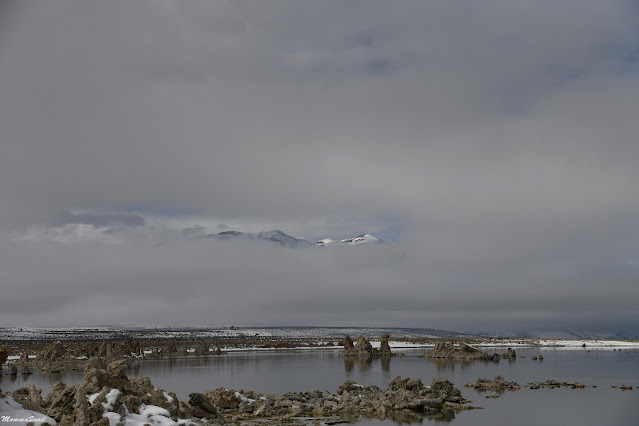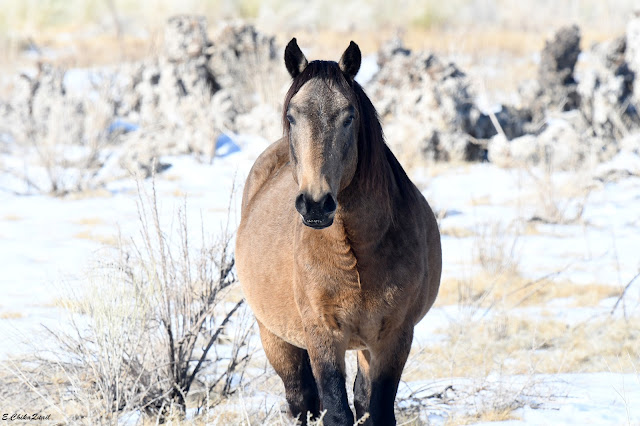 |
| Alameda Creek |
 |
| My hike as captured by my GPS |
It wasn't all that early when I arrived at the parking lot but I found it empty of cars. As I made my way to the bridge that crosses the creek I saw a number of vans getting through the Ohlone Camp Road gate, which is closed to the general public. The vans belonged to the San Francisco Water Company which manages the reservoir upstream of the park area. One of the men told me that they were going to check the dam. After they passed me I paused on the bridge and gazed down at the fast flow of water below.
 |
| Alameda Creek |
The morning was overcast but the rains have ceased for the time being. I started up the familiar gravel road but as soon as I passed the first cattle guard I veered right on the first footpath stream access.
 |
| Ohlone Camp Road |
At the end of the footpath there's a waterhole. Not a hole really, but a wider and flatter part of the creek where at warmer days people like to come to and enjoy the water. Now the usually calm 'pool' was flowing fast and furious.
I looked with awe at the gashing whirlpools formed downstream of the waterhole. Running high, this creek could be dangerous.
At the creek bank in that location there are rocks loaded with fossils of seashells. I walked over to check them out. After being washed well by the rains the fossils looked as if they were embedded there recently. They are about 5-20 million years old though, a Miocene Briones formation.
 |
| Fossils |
From that location it is possible to walk upstream right along the bank when the water is lower and calmer. Now of course, the water covered the path and I wouldn't have risked it even if I was tempted to step into the cold water.
 |
| Alameda Creek |
I returned to the Ohlone Camp Road and continued walking up the trail. Most of the trees along the road are oaks and many of them are Valley oaks which are deciduous. Nearly all of them have dropped their leaves already but a few were still hanging on, displaying late fall colors. The other common deciduous trees there, the California Buckeyes, were completely bare for quire some time now. They are the first to drop their leaves.
All around me I heard the loud, raspy calls of acorn woodpeckers. There are many of them in the area, and they were very active. None of them was close enough or stayed put long enough for me to get a decent photo but I did manage to capture one of these beautiful birds as it hanged from the side of a branch. That's the little red dot in the middle of the photo below. Better click on the photo to enlarge it.
 |
| Acorn Woodpecker |
More water company vans were coming up the road and I started planning in my mind escaped routes in case the dam breaks ... I was mildly surprised that I didn't see any other hikers though.
 |
| Ohlone Camp Road |
Shortly before the Little Yosemite area there's a bench and a view point near a large rock protrusion. I didn;t stop at the bench but I did go over to the view point and looked up the gulch. The valley cut by Alameda Creek used to be the main path of commute between Livermore area and the Bay communities in the early days of modern settlement. This narrow rocky area of the creek valley was also a place where bandits used to ambush the passer by people and rob them.
I wasn't looking for any wildflowers. I didn't expect to see any this time of year. The bright red color belongs to the ripening berries of the Toyon bush. When they are ripe I like to chew on them when I see them on my local hikes.
 |
| Toyon. Heteromeles arbutifolia |
Coffee Fern (no relations to true coffee) is a dry-resistant fern that adorns many exposed slopes in the East Bay. Even this dry-tolerant fern enjoyed the longed for rains.
 |
| Coffee Fern, Pellaea andromedifolia |
I passed the second cattle guard and immediately turned to the right on another footpath leading to the bottom of the Little Yosemite area. There's a series of cascades there that spill into a large waterhole. That waterhole too is a very popular hangout place on the summer. Now it was nearly impossible to tell all the cascade drops from one-another, and the waterhole wasn't visible at all. It wasn't the highest I've seen this creek, but it was close to it.
 |
| Alameda Creek |
I focused on the main 'waterfall' in that cascade series. The previous time I hiked there was in September, and the water trickled so thinly that I wasn't able to see where it came down the rocks. I now stood there for a long time just enjoying the sight of that luxurious flow.
Coming back from the lower view point I continued up the gravel road to the Little Yosemite area. On the way I saw a pretty coyote brush that was still hanging on to its snow-white seeds.
 |
| Coyote Brush, Baccharis pillularis |
People who've seen the real Yosemite scoff at the name given to this part of the Alameda Creek. This local rocky canyon does not match the grandeur of actual Yosemite but it does stands out on its own as a gorgeous natural feature by its own right.
 |
| Fall Colors at Little Yosemite |
Here too the flow was strong and impressive. I watched from above for some time but didn't go down to the water.
Even the waterhole here was fully covered and invisible under the high current. In the hot summer days it is fun to wade to that small waterfall and sit underneath for a good back massage. Now of course, that would be insane to do so.
I continued a bit more upstream to where the water come from a flatter, calmer stretch of the creek and then funnel into the narrow drop of upper Little Yosemite. That was quite a sight to see.
But even the flatter area, where I usually do go down to the water on my hikes there, was flowing rapidly.
 |
| Alameda Creek |
That was where I turned around and started returning down the road. The road is packed gravel but here and there some of the local big rocks show through, including this beautiful deep blue rock which I was told was blueschist. I know this rock from my previous hikes but I loved seeing it all washed up and glistening.
 |
| Blueschist |
On my way down the road I also realized that the trail wasn't devoid of wildflowers despite the season. The sagebrush shrubs were blooming. Strings of small, unassuming inflorescence heads were extending from the grayish shrubs. The recent rains have also intensified the aroma of these bushes and I was very tempted to pick some for my tea (but I didn't).
 |
| California Sagebrush, Artemisia californica |
The clouds were breaking up and by now I also started seeing other hikers coming up the trail. Singles and couples, mainly. The day was already beautiful and was turning even more so. It was great to see the bright blue sky without the air pollution we take as normal these days.
 |
| Ohlone Camp Road |
Most of the oak tree trunks there are holed into acorn granaries by the acorn woodpeckers. This year was a mast year for the oaks in the area and the granaries were full to the last hole.
 |
| Woodpecker Granary |
There were heavy clouds lingering still over Flag Hill but they too were receding. I hiked there a while ago. Perhaps it is time to revisit that trail now that the hill was greening up.
 |
| Flag Hill |
There's a large oak tree hanging over the road near the bridge and that oak is loaded with mistletoe - a semi-parasite plant that like the oak, feeds many animal species (birds in particular) with its berries. When a valley oak drops its leaves in the fall, the mistletoe balls are the only green on the tree until springtime.
 |
| Mistletoe, Phoradendron leucarpum, on Valley Oak, Quercus lobata |
The large oak standing right by the gate was still holding on to its leaves. Not for much longer, I suppose. The winter we waited for for three years now has finally arrived, and I hope it would stay for a long while.




































